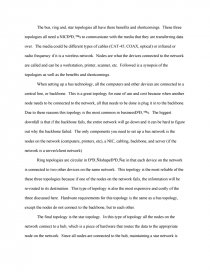Network Topologies Checkpoint
Essay by review • February 24, 2011 • Essay • 463 Words (2 Pages) • 1,276 Views
The bus, ring and, star topologies all have there benefits and shortcomings. These three topologies all need a NIC’s to communicate with the media that they are transferring data over. The media could be different types of cables (CAT-45, COAX, optical) or infrared or radio frequency if it is a wireless network. Nodes are what the devices connected to the network are called and can be a workstation, printer, scanner, etc. Followed is a synopsis of the topologies as well as the benefits and shortcomings.
When setting up a bus technology, all the computers and other devices are connected to a central line, or backbone. This is a great topology for ease of use and cost because when another node needs to be connected to the network, all that needs to be done is plug it in to the backbone. Due to these reasons this topology is the most common in business’s. The biggest downfall is that if the backbone fails, the entire network will go down and it can be hard to figure out why the backbone failed. The only components you need to set up a bus network is the nodes on the network (computers, printers, etc), a NIC, cabling, backbone, and server (if the network is a server/client network)
Ring topologies are circular in “shape” in that each device on the network is connected to two other devices on the same network. This topology is the most reliable of the these three topologies because if one of the nodes on the network fails, the information will be re-routed to its destination. This type of topology is also the most expensive and costly of the three discussed here. Hardware requirements for this topology is the same as a bus topology, except the nodes do not connect to the backbone, but to each other.
The final topology is the star topology. In this type of topology all the nodes on the network connect to a hub, which is a piece of hardware that routes the data to the appropriate node on the network. Since all nodes are connected to the hub, maintaining a star network is easy because if you need to change settings of the network, you can just reconfigure the hub as apposed to changing each node. Adding or removing nodes is also simplified since, like a bus topology, the nodes all connect to a centralized piece of hardware, in this case a hub. Also like a bus topology though, if this centralized piece of hardware fails, the whole network will fail. The hardware requirements
...
...

